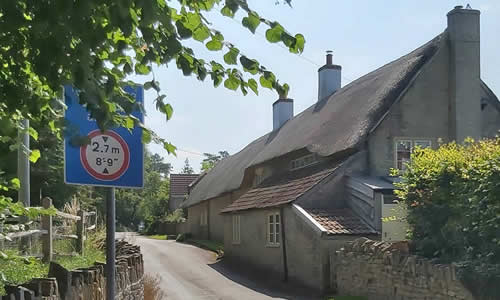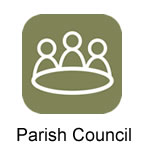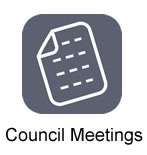The Parish History
Charlton Mackrell is one of a pair of villages (the other being Charlton Adam) lying some 3 miles E of Somerton on the N bank of the river Cary in south central Somerset. The Fosse Way, linking Bath with Axminster and Exeter, runs approximately a mile to the E of the village. The church stands on the southern edge of the village and is a cruciform building of local lias cut and squared, with Hamstone ashlardressings. It consists of a crossing tower, N and S transepts, nave with S porch and chancel. The oldest parts of the fabric appear to be 13thc, but there is a late-12thc font, described below. The church was restored in 1792-94 and 1847.
Before the Conquest Charlton Mackrell was held by Aethelfrith, and in 1086 by Roger Arundel himself. It was rated at 3 hides, with 30 acres of meadow and 2 acres of woodland. The ownership of the manor is not recorded again until 1220, when it is part of the Arundel barony. At the death of Roger Arundel II in 1165 the manor passed to his sister Maud, married to Gerbert de Percy (d.1179). On Maud’s death the manor and church were divided between her daughters Sybil and Alice. Sybil’s moiety passed through her marriage to the de Poles, and then the FitzPayns, who held it until the 14thc. Alice’s moiety passed through her marriage to the Newburghs (her daughter Maud married Roger de Newburgh). Roger’s son Robert de Newburgh granted the mesne lordship of his moiety to his sister, Margery Belet, to be held from him, and she further subinfeudated the property by granting it to William de Horsey (to be held from her). William later eased the confusion to some extent by buying the mesne lordship from Margery’s grandson, William Belet. The overlordship appears to have passed for a time to Queen Eleanor of Castile after 1276, but to have returned to Newburghs thereafter. The advowson of the church descended initially with the FitzPayn family, but in 1224 the right of alternate presentation was conveyed by Roger FitzPayn to Margery Belet, then owner of the second moiety of the manor, and passed with that moiety to the Horsey family. The benefices of Charlton Adam and Charlton Mackrell were united in 1921.
Charltons Historical Society Website
The Church of St. Peter and St. Paul, Charlton Adam
The Church of St. Peter and St. Paul consists of chancel, nave, south chapel and porch and west tower. The chancel is early 14th century in origin with a 15th century east window. The rest of the fabric seems to be mainly 15th century but the chapel may be a trifle later. The restored roofs are of the local wagon type so characteristic of the West Country. The church was restored in 1893, though, fortunately, much less drastically than was the case at Charlton Mackrell in 1847. The material is the local lias stone with Ham stone dressings.
The pulpit is 17th century of simple Jacobean character. Between the chapel and the chancel is a wide skewed arch and passage. The monuments include one to Thomas Basket (1592) with strap cartouche and inscriptions between two columns, the whole surmounted by a pediment. The font with round bowl and shaft is late 12th century. Note also mural monuments to Anne Strangways (1638) and Giles Strangways (1677). There are numerous inscribed slate memorial slabs of the 17th and 18th centuries.
The plate includes an Elizabethan silver parcel gilt communion cup and a silver paten Of 1718. One of the five bells is of mediaeval date. The late Mr and Mrs C Neville of the Abbey, were great benefactors to the church. Their benefactions include a large panel painting of the Blessed Virgin with St Matthew and St Jerome from the Zouche collection at Parham, Sussex, the Crucifixion over the chancel arch, a copy of one in Florence and painted by Mrs. Neville who was herself an accomplished artist. She also painted and presented the altarpiece - a copy of a fresco by Perugino. The wooden altar candlesticks are of foreign origin and probably 18th century. Note also the altar table and chandelier in the chancel, both of 18th century date. The choir stalls and seating generally are good modern work in harmony with their surroundings. There are a few fragments of 15th century painted glass in the west window. The registers are less ancient than many, the earlier books being lost. Baptisms and Burials begin in 1704, and Marriages in 1707. In the churchyard is the restored cross. The steps and base are medieval but the rest dates only from 1911 and is inspired by one at Crowcombe, in West Somerset. The restoration was effected in memory of the Rev. PW and Mrs. Bryan.
The Church of St. Mary the Virgin, Charlton Mackrell
The church of St. Mary the Virgin consists of chancel, north vestry, central tower, transepts, nave and south porch. The fabric is of 14th century origin with much refashioning in the 15th century but a drastic restoration of circa 1847 has somewhat obscured the architectural history. The most outstanding feature is the end window of the north transept with elaborate and beautiful tracery of about 1330. The rest of the windows have been largely renewed but two excellent drawings of J. C. Buckler, in 1834, show that the present fenestration to a certain extent follows the old lines. The plan suggests a Norman origin but no features of that period remain as is the case with some other churches of the same plan in Somerset.
The Victorian renovation involved the rebuilding of the porch, roofs and most of the windows and the addition of the vestry which replaced one of uncertain date on the opposite side of the chancel. The work was quite competently executed and, judging by the above mentioned drawings by Buckler, was a fairly faithful reproduction of what was there before, so far as the exterior was concerned, though it is difficult to understand why it was considered necessary to do so much renewal. The elaborate roofs are quite good and much better than might have been expected at that date: it is probable that some at least of the carved bosses in the nave are medieval. The tower has a southwest stair turret crowned with a modern spirelet quite in the old manner.
The lovely end window of the north transept has the ball flower ornament typical of the period on the rere arch. Originally this window was filled with contemporary painted glass depicting the Five Joys of Our Lady with the kneeling figures of William le Lyt and his wife Agnes at the bottom as recorded by Thomas Lyte, in 1631. This glass has long disappeared but Thomas Lyte made drawings of the figures at the bottom that he had engraved on a stone slab and set up in the chapel at Lytes Cary. The tomb of William le Lyt and his wife was formerly in the north transept but was eventually, probably in the middle of the last century, destroyed and the Purbeck marble slab with their effigies thrown out into the churchyard. Here it still remains in a very decayed condition under a yew tree. The old font of late 12th century date is now in the north transept and has been discarded in favour of a modern successor.
Some of the early 16th century bench ends have been mercifully spared. They are mostly straight headed but a few have poppyheads. One has a satyr depicted and another the Percy coat of arms (this family inherited the Fitzpaine property in the 15th century and were here until about 1537) but the majority have tracery designs. Note the foliated squints on each side of the chancel arch and the tomb recess under the end window of the south transept. There are two chandeliers probably of the 18th century.
The following mural tablets should be noted, all with heraldic achievements - Simon Whetcombe (1657), William Dodd (1760), Mary Pyne (1770), Lydia Dodd (1778) and George Page (1822). There is an 18th century table.
The registers of Baptisms, Marriages and Burials begin in 1575; an entry of 19th October 1609 relates to the marriage of Henry Adams and Edith Squire from whom descended two Presidents of the United States, John who succeeded George Washington and John Quincy, the sixth.
The Plate includes a communion cup of 1570. There are six bells, one of which is dated 1665 and another 1788. The west window contains some fairly early 19th century painted glass and is interesting as an early instance of the revival of this art. The churchyard cross which was well restored in 1923, exhibits the Evangelistic symbols on the base.
Charlton Mackrell Church of England Primary School
There is a history of Charlton Mackrell school on the school's website.






